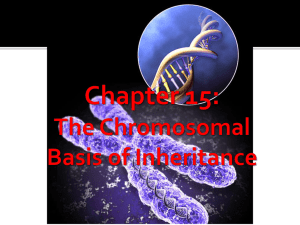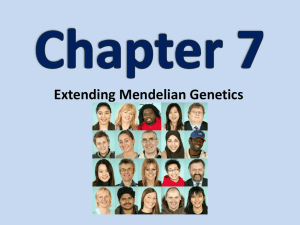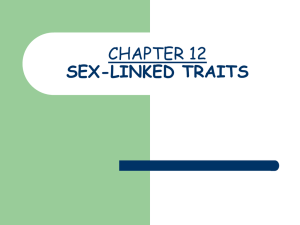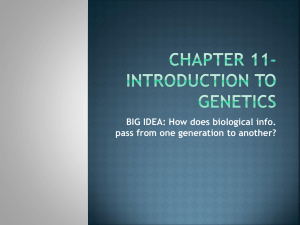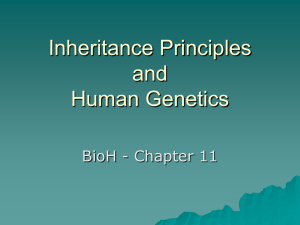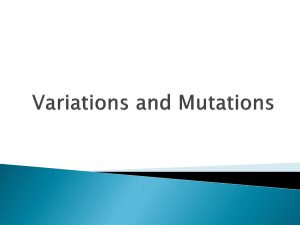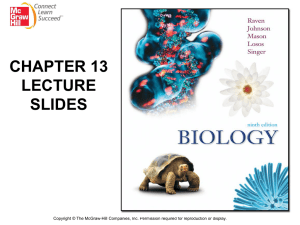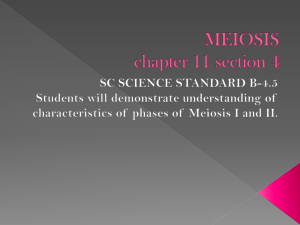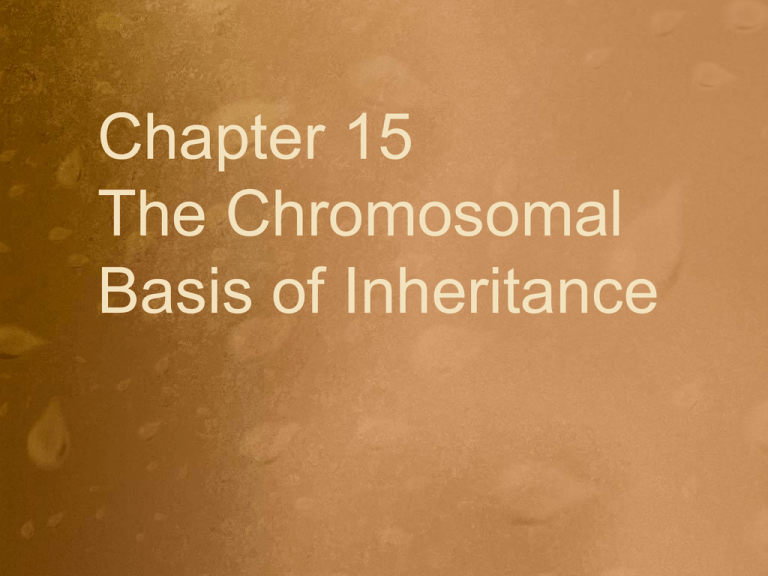
Chapter 15
The Chromosomal
Basis of Inheritance
Timeline
•
•
•
•
1866- Mendel's Paper
1875- Mitosis worked out
1890's- Meiosis worked out
1902- Sutton, Boveri et. al. connect
chromosomes to Meiosis.
• Parents are two true-breeding pea plants
• Parent 1 Yellow, round Seeds (YYRR)
• Parent 2 Green, wrinkled seeds (yyrr)
These 2 genes are on different chromosomes.
Draw meiosis to determine the resulting gametes of parent 1.
How do the resulting gametes connect to Punnett squares?
• F1:
YyRr x YyRr
• What are the predicted phenotypic
ratios of the offspring?
• ¾ yellow
¾ round
• ¼ green
¼ wrinkled
¼ (green) x ¼ (wrinkled) = 1/16 green, wrinkled
9:3:3:1 phenotypic ratio
First Experimental Evidence to connect
Mendelism to the chromosome
• Thomas Morgan (1910)
• Chose to use fruit flies as a test
organism in genetics.
• Allowed the first tracing of traits to
specific chromosomes.
Fruit Fly
• Drosophila melanogaster
• Early test organism for genetic studies.
Reasons
•
•
•
•
•
Small
Cheap to house and feed
Short generation time
Many offspring
3 pairs of Autosomes
• 1 pair of sex chromosomes
Examples
• Wild type is most common,
NOT dominant or recessive
• Recessive mutation:
• w = white eyes
• w+ = red eyes
• Dominant Mutation
• Cy = Curly wings
• Cy+ = Normal wings
Morgan Observed:
• A male fly with a mutation for white
eyes.
Morgan crossed
• The white eye male with a normal red
eye female.
• Male ww x Female w+w+
The F1 offspring:
• All had red eyes.
• This suggests that white eyes is a
_________?
• Recessive.
• F1= w+w
• What is the predicted phenotypic ratio
for the F2 generation?
F1 X F1 = F2
• Expected F2 ratio - 3:1 of red:white
• He got this ratio, however, all of the
white eyed flies were MALE.
• Therefore, the eye color trait appeared
to be linked to sex.
Morgan discovered:
• Sex linked traits.
• Genetic traits whose gene are located
on the sex chromosome
Fruit Fly Chromosomes
• Female
•
XX
Male
XY
• Presence of Y chromosome
determines the sex
• Just like in humans!
Morgan Discovered
• There are many genes, but only a
few chromosomes.
• Therefore, each chromosome must
carry a number of genes together as
a “package”.
Sex-Linked Problem
• A man with hemophilia (a recessive, sexlinked, x-chromosome condition) has a
daughter of normal phenotype. She marries
a man who is normal for the trait.
• A. What is the probability that a daughter of this mating will
be a hemophiliac?
• B. That a son will be a hemophiliac?
• C. If the couple has four sons, what is the probability that
all four will be born with hemophilia?
• Original Man - XhY
• Daughter - must get the dad’s X chromosome
XHXh (normal phenotype, so she’s a carrier)
• Daughter’s husband XHY (normal phenotype)
• A. daughter must get XH from the dad. 0% (50%
carrier, 50% homo dom.)
• B. son must get Y from dad. 50% chance to be
hemophiliac
• C. ½ x ½ x ½ x ½ = 1/16
Linked Genes
• Traits that are located on the same
chromosome.
• Result:
• Failure of Mendel's Law of
Independent Assortment.
• Ratios are different from the
expected
Example:
• Body Color - gray dominant
• b+ - Gray
• b - black
• Wing Type - normal dominant
• vg+ - normal
• vg – vestigial (short)
Example
b+b vg+vg X bb vgvg
Predict the phenotypic ratio of the
offspring
Show at board
b+b x bb
vg+vg x vgvg
½ gray ½ black
½ normal ½ vestigial
----------------------------------------------------¼ gray normal, ¼ gray vestigial,
¼ black normal, ¼ black vestigial
1:1:1:1 phenotypic ratio
Conclusion
• Most offspring had the parental phenotype.
Both genes are on the same chromosome.
• What do you expect to happen if they’re on
the same chromosome? (draw
chromosomes)
• bbvgvg parent can only pass on b vg
• b+b vg+vg can pass on b+ vg+ or b vg
b+b vg+vg - Chromosomes
(linked genes)
Crossing-Over
• Breaks up linkages and creates new
ones.
• Recombinant offspring formed that
doesn't match the parental types.
• Higher recombinant frequency = genes
further apart on chromosome
If Genes are Linked:
• Independent Assortment of traits fails.
• Linkage may be “strong” or “weak”.
• Strong Linkage means that 2 alleles
are often inherited together.
• Degree of strength related to how close
the traits are on the chromosome.
Genetic Maps
• Constructed from crossing-over
frequencies.
• 1 map unit = 1% recombination
frequency.
• Can use recombination rates to
‘map’ chromosomes.
• Comment - only good for genes that
are within 50 map units of each other.
Why?
• Over 50% gives the same phenotypic ratios
as genes on separate chromosomes
Genetic Maps
• Have been constructed for many traits
in fruit flies, humans and other
organisms.
Sex Linkage in Biology
•
1.
2.
3.
4.
Several systems are known:
Mammals – XY and XX
Diploid insects – X and XX
Birds – ZZ and ZW
Social insects – haploid and diploid
Chromosomal Basis of Sex in
Humans
• X chromosome - medium sized
chromosome with a large number of
traits.
• Y chromosome - much smaller
chromosome with only a few traits.
Human Chromosome Sex
• Males - XY
Females - XX
• Comment - The X and Y chromosomes
are a homologous pair, but only for a
small region at one tip.
SRY
• Sex-determining Region
Y chromosome gene.
• If present - male
• If absent - female
• SRY codes for a cell receptor.
Sex Linkage
• Inheritance of traits on the sex
chromosomes.
• X- Linkage (common)
• Y- Linkage (very rare if exists at all)
Males
• Hemizygous - 1 copy of X
chromosome.
• Show ALL X traits (dominant or
recessive).
• More likely to show X recessive
gene problems than females.
X-linked Disorders
•
•
•
•
Color blindness
Duchenne's Muscular Dystrophy
Hemophilia (types a and b)
Immune system defects
Samples of X-linked patterns:
X-linked Patterns
• Trait is usually passed from a
carrier mother to 1/2 of sons.
• Affected father has no affected
children, but passes the trait on to
all daughters who will be carriers
for the trait.
Comment
• Watch how questions with sex linkage
are phrased:
• Chance of children?
• Chance of males?
Can Females be color-blind?
• Yes, if their mother was a carrier and
their father is affected.
Y-linkage
• Hairy ear pinnae.
• Comment - new techniques have
found a number of Y-linked
markers that can be shown to run
in the males of a family.
• Ex: Jewish priests
Sex Limited Traits
• Traits that are only expressed in one
sex.
• Ex – prostate
Sex Influenced Traits
• Traits whose expression differs
because of the hormones of the
sex.
• These are NOT on the sex
chromosomes.
• Ex. – beards, mammary gland
development, baldness
Baldness
• Testosterone – the trait act as a
dominant.
• No testosterone – the trait act as a
recessive.
• Males – have gene = bald
• Females – must be homozygous to
have thin hair.
Barr Body
• Inactive X chromosome observed in the
nucleus.
• Way of determining genetic sex without
doing a karyotype.
Lyon Hypothesis
• Which X inactivated is random.
• Inactivation happens early in
embryo development by adding
CH3 groups to the DNA.
• Result - body cells are a mosaic of
X types.
Examples
• Calico Cats.
• Human examples are known such
as a sweat gland disorder.
Calico Cats
• XB = black fur
• XO = orange fur
• Calico is heterozygous, XB XO.
Question?
• Why don’t you find many calico males?
• They must be XB XOY and are sterile.
Chromosomal Alterations
• Changes in number.
• Changes in structure.
Number Alterations
• Aneuploidy - too many or too few
chromosomes, but not a whole “set”
change.
• Polyploidy - changes in whole “sets” of
chromosomes.
Nondisjunction
• When chromosomes fail to separate
during meiosis
• Result – cells have too many or too few
chromosomes which is known as
aneuploidy
Meiosis I vs Meiosis II
• Meiosis I – all 4 cells are abnormal
• Meiosis II – only 2 cells are abnormal
Aneuploidy
• Caused by nondisjunction, the failure of
a pair of chromosomes to separate
during meiosis.
Types
• Monosomy: 2N - 1
• Trisomy: 2N + 1
Turner Syndrome
• 2N - 1 or 45 chromosomes
Genotype: X_ or X0.
• Phenotype: female, but very poor
secondary sexual development.
Characteristics
•
•
•
•
•
Short stature.
Extra skin on neck.
Broad chest.
Usually sterile
Normal mental development except
for some spatial problems.
Question
• Why are Turner Individuals usually
sterile?
• Odd chromosome number.
• Two X chromosomes need for ovary
development.
Homework
•
•
•
•
Read Chapter 15 (Hillis – 8)
Genetics Lab Report – today
No class Feb. 4 and 5
Chapter 15 – Thurs. 2/7
Other Sex Chromosome changes
• Kleinfelter Syndrome
• Meta female
• Supermale
Kleinfelter Syndrome
• 2N + 1
• Genotype: XXY
• Phenotype: male, but sexual
development may be poor. Often
taller than average, mental
development fine, usually sterile.
Meta female
• 2N + 1 or 2N + 2
• Genotype: XXX or XXXX
• Phenotype: female, but sexual
development poor. Mental impairment
common.
Super male
• 2N + 1 or 2N + 2
• Genotype: XYY or XYYY
• Phenotype: male, usually normal,
fertile.
Trisomy events
• Trisomy 21: Down's Syndrome
• Trisomy 13: Patau Syndrome
• Both have various physical and
mental changes.
Question?
• Why is trisomy more common than
monosomy?
• Fetus can survive an extra copy of a
chromosome, but being hemizygous is
usually fatal.
Question?
• Why is trisomy 21 more common in
older mothers?
• Maternal age increases risk of
nondisjunction.
Polyploid
• Triploid= 3N
• Tetraploid= 4N
• Usually fatal in animals.
Question?
• In plants, even # polyploids are
often fertile, why odd # polyploids
are sterile. Why?
• Odd number of chromosomes can’t
be split during meiosis to make
spores.
Structure Alterations
•
•
•
•
Deletions
Duplications
Inversions
Translocations
Translocations
Result
• Loss of genetic information.
• Position effects: a gene's expression is
influenced by its location to other
genes.
Cri Du Chat Syndrome
• Part of p arm of #5 missing.
• Good survival, but low birth weight and
slow gain.
• Severe mental impairment.
• Small sized heads common.
Cri Du Chat Syndrome
Philadelphia Chromosome
• An abnormal chromosome produced by
an exchange of portions of
chromosomes 9 and 22.
• Causes chronic myeloid leukemia.
Parental Imprinting of Genes
• Gene expression and inheritance
depends on which parent passed on
the gene.
• Usually caused by different
methylations of the DNA.
Example:
• Prader-Willi Syndrome and
Angelman Syndrome
• Both lack a small gene region from
chromosome 15.
• Male imprint: Prader-Willi
Female imprint: Angelman
Cause:
• Imprints are "erased" in gamete
producing cells and re-coded by the
body according to its sex.
• Gametes are methylated to code as
“male “ or “female”.
Result
• Phenotypes don't follow Mendelian
Inheritance patterns because the sex of
the parent does matter.
Extranuclear Inheritance
• Inheritance of genes not located on the
nuclear DNA.
• DNA in organelles.
• Mitochondria
• Chloroplasts
Result
• Mendelian inheritance patterns fail.
• Maternal Inheritance of traits where the
trait is passed directly through the egg
to the offspring.
Chloroplasts
• Gives non-green areas in leaves, called
variegation.
• Several different types known.
• Very common in ornamental plants.
Variegation in
Violets
African
Variegated Examples
Mitochondria
•
•
•
•
Myoclonic Epilepsy
Ragged Red-fiber Disease
Leber’s Optic Neuropathy
All are associated with ATP
generation problems and affect
organs with high ATP demands.
Comment
• Cells can have a mixture of normal and
abnormal organelles.
• Result - degree of expression of the
maternal inherited trait can vary widely.
Summary
• Know about linkage and crossing-over.
• Sex chromosomes and their pattern of
inheritance.
Summary
• Be able to work genetics problems for
this chapter.

